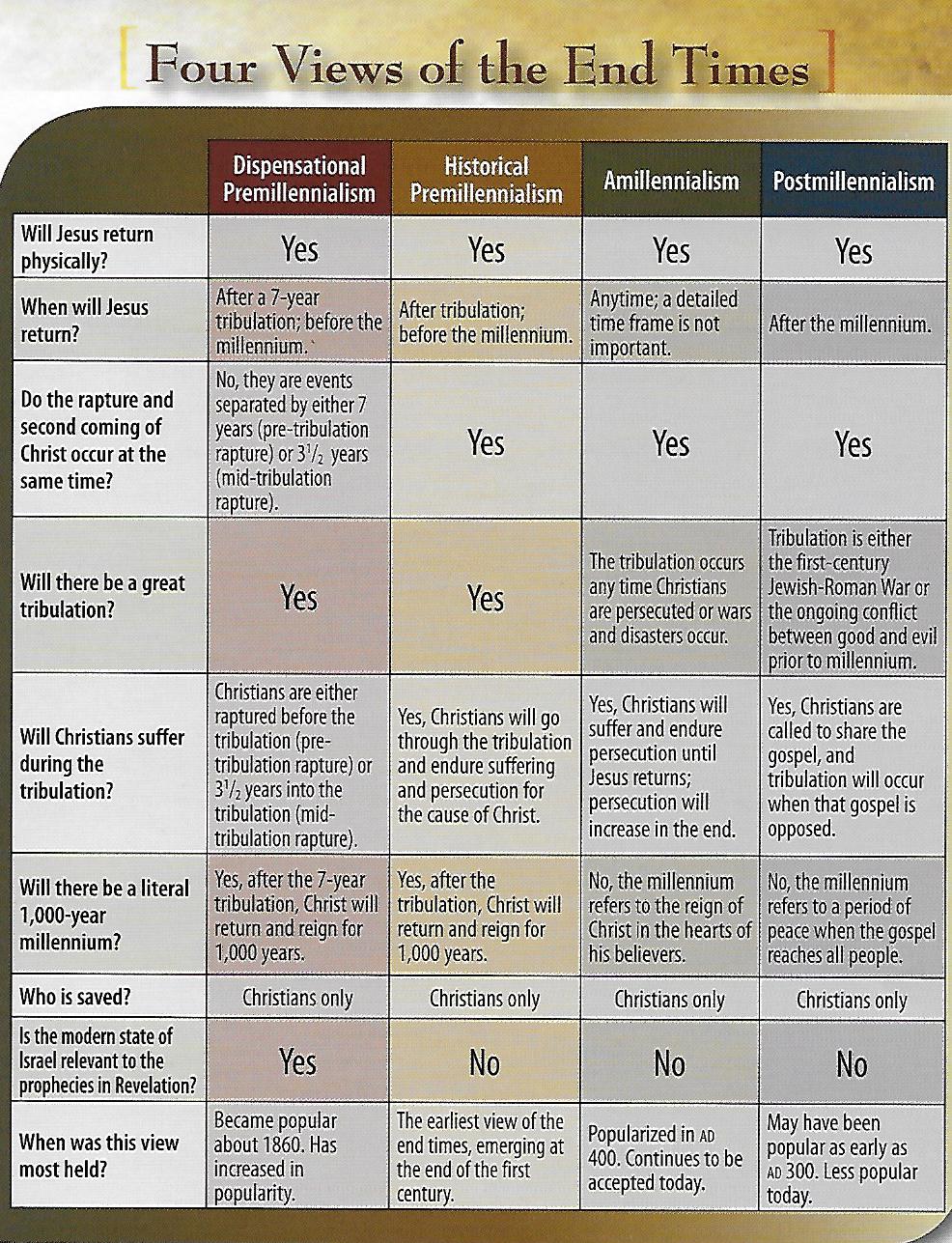The 2nd Coming of Jesus – Distinctives
Dispensational Premillennialism;
They believe that the rapture and the 2nd Coming are two separate events that are divided by the Tribulation, so they are mostly pre-tribulationists. A few of them are mid-tribulationists.
– they believe that during the tribulation, many Jews will come to faith in Christ. – that the Jews will receive the land promised in Genesis 15:18.
– that the establishment of the state of Israel in 1948 fulfills a key end times prophecy.
– that all references to Israel in Revelation refer to the nation of Israel.
– that the Church is not mentioned between Revelation chapters 4 thru 19.
– during the tribulation, natural disasters and wars will happen and people who become Christians will suffer severe persecution.
– that the Church and Israel are two distinct entities. The Church is not New Testament Israel and did not inherit the promises made to Israel.
– that Christians will not receive the Mark of the Beast but everyone else will.
– it is the most literal end times scenario, especially regarding the book of Revelation.
This view emerged in the 1800’s and has increased in popularity since then. Today it is the most popular end times view.
Prominent believers: Tim LaHaye, Hal Lindsey, Chuck Smith, John MacArthur, Charles Stanley, Norn Geisler, the Left Behind book series.
Historic Premillennialism;
They believe that the rapture and the 2nd Coming are the same event, so they are post-tribulationists.
– they believe that the Church will remain on the earth during the tribulation.
– the Church has replaced Israel as God’s covenant people. The Church is New Testament Israel.
– they treat the millennium as a 1,000 year future event.
– they treat Revelation as both symbolic and literal.
– most references to Israel in Revelation refer to the Church.
– the revealing of the anti-Christ is before the 2nd Coming (2nd Thessalonians 2:3,4)
– the tribulation will root out false believers (Revelation 2:22,23)
– the New Testament frequently uses “Israel” and “the 12 tribes” as references to Christians (Matthew 19:28,29, Romans 9:6-8)
This view seems to be the earliest end times view among believers who lived just after the apostles. Early Church fathers, such as Lactantius (240-320 A.D.), Irenaeus (130-200 A.D.), Justin Martyr (100-165 A.D.) and Papias (60-130 A.D.) held this view. Modern day supporters are John Warwick Montgomery, Robert Gundry and George Eldon Ladd.
Postmillennialiism;
They believe the 2nd Coming of Jesus will happen at the end of the millennium. The millennium will start at some unknown point when most of the world will become believers thru the gospel preaching. During this time, Satan has no power over believers and evil will collapse in the world (Revelation 19:19-20:3).
In essence, the world will get more and more Christianized.
– during the millennium, Christ will rule the earth thru His Spirit and His Church, but He will not be physically present.
– the 2nd Coming, the defeat of Satan, the resurrection of all people, the final judgment, and eternity will start right after the millennium (Daniel 12:2,3; John 5:28,29; Matthew 24:14; Mark 13:10).
The earliest postmillennialist was Joachim of Fiore (1135-1202 A.D.), although some scholars believe that there were earlier believers. It increased in popularity in the 1800’s, but due to two world wars and a depression, it diminished by the mid-1900’s.
Prominent believers: Jonathan Edwards, B.B.Warfield, D. James Kennedy and R.C. Sproul.
Amillennialism;
They believe that the millennium is a symbolic time period, not 1,000 literal years. It started with Christ’ victory over Satan by His resurrection from the dead in 32 A.D. The 2nd Coming of Jesus, the resurrection of the dead, judgment and eternity will all start then.
– they believe that the tribulation represents disasters, wars, and persecutions that the Church has faced throughout history.
– most references to Israel are symbolic references to the Church (compare Romans 9: 6-8 to Galatians 6:16).
– in apocalyptic literature, numbers represent concepts, not literal numbers. 6 represents incompleteness, 7 represents completeness, 12 represents perfection and 1,000 means a long period of time.
– the bible uses 12,000 figuratively (Psalm 50:10 90:4, 2nd Peter 3:8).
Amillennialism became popular in the 5th century. It was embraced by the Roman Catholic Church and is popular today in mainline churches.
Prominent believers; Augustine, Martin Luther, John Calvin, Stanley Grenz, J.I. Packer and Anthony Hoekma.
Believers can hold to any of these end time views. Amillennialism is most popular among mainline churches. Dispensational Premillennialism is the most popular among evangelicals because it is the most literal interpretation. Obviously, popularity does not ensure what is biblically true.
No matter what end time view you decide on, please remember that in all of them, Jesus is the Conqueror and the coming victorious King of Kings. He will set up His kingdom and will rule for all eternity (Revelation 21:1-7).
“He who testifies to these things says, ‘Yes, I am coming soon.’ Amen, Come, Lord Jesus.” (Revelation 22:20).
Book References:
“Understanding End Times Prophecy” by Paul Benware
“The New Millennium Manual: A Once and Future Guide” by Robert Clouse, Robert Hosack & Richard Pierard
There are many, many other good books on this subject. Consult Amazon Books, Christian Book Distributors or Bible Gateway Books.
Website references:
https://www.blueletterbible.org/faq/mill.cfm
http://www.ccel.org/contrib/exec_outlines/end/end_01.htm
http://www.natewilsonfamily.net/eschtlgy.htm
For His Kingdom,
Dave Maynard
http://BSSSB-LLC.com








